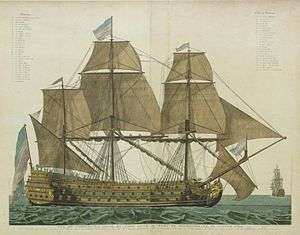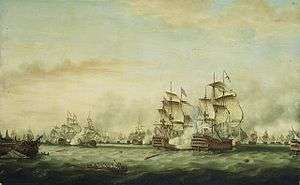French ship Ville de Paris (1764)
 Ville de Paris in Rochefort, 1764 | |
| History | |
|---|---|
| Name: | Impétueux |
| Ordered: | as Impétueux |
| Builder: | Rochefort harbour |
| Laid down: | 1757 |
| Commissioned: | 1764 |
| Renamed: | Ville de Paris in 1762 |
| Fate: | sank September 1782 |
| General characteristics | |
| Class and type: | First-rate ship of the line |
| Length: | 54 m (177 ft) |
| Beam: | 14.6 m (48 ft) |
| Draught: | 6.7 m (22 ft) |
| Propulsion: | Sail |
| Armament: |
|
| Armour: | Timber |
Ville de Paris was a large three-decker French ship of the line that became famous as the flagship of the Comte de Grasse during the American Revolutionary War.
Originally laid down in 1757 as the 90-gun Impétueux, she was funded by the City of Paris and renamed Ville de Paris in 1762 as a result of the don des vaisseaux, Duc de Choiseul’s campaign to raise funds for the navy from the cities and provinces of France.
She was completed in 1764 as a 90-gun first rate, just too late to serve in the Seven Years' War. She was one of the first three-deckers to be completed for the French navy since the 1720s.
In 1778, on the French entry into the American Revolutionary War she was commissioned at Brest, joining the fleet as the flagship of the Comte de Guichen. In July she fought in the indecisive Battle of Ushant (1778).
At some point during the next two years, she had an additional 14 small guns mounted on her previously unarmed quarterdeck, making her a 104-gun ship.
In March 1781 she sailed for the West Indies as flagship of a fleet of 20 ships of the line under the Comte de Grasse. She then fought at the Battle of Fort Royal, the Battle of the Chesapeake and the Battle of St. Kitts as De Grasse's flagship.

At the Battle of the Saintes on 12 April 1782, the British fleet under Admiral Sir George Rodney defeated the French fleet under the Comte de Grasse, and captured Ville de Paris.
The ship did not live up to the motto of her namesake city, Fluctuat nec mergitur (Latin: Tossed by the waves, she does not sink), for she sank in September 1782 with other ships when the 1782 Central Atlantic hurricane hit the fleet off Newfoundland Admiral Graves was leading back to England. Ville de Paris sank with the loss of all hands but one.
A ship of the line of the Royal Navy was named after her: HMS Ville de Paris, launched in 1795.